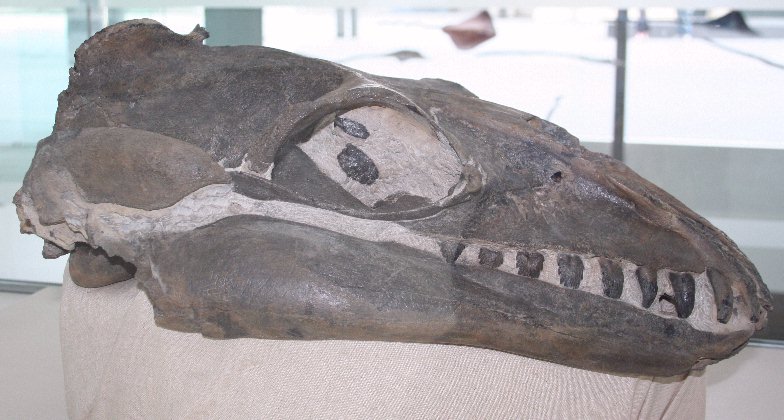- Janjucetus
Taxobox

name = "Janjucetus"
fossil_range = LateOligocene
regnum =Animal ia
phylum =Chordata
classis =Mammal ia
ordo =Cetacea
subordo =Mysticeti
familia = Janjucetidae
familia_authority = Fitzgerald,2006
genus = "Janjucetus"
genus_authority = Fitzgerald,2006
species = "J. hunderi"
binomial = "Janjucetus hunderi"
binomial_authority = Fitzgerald,2006 "Janjucetus" was a
genus of fossilwhale that represents a basal form of theMysticeti , a group which includes the extantbaleen whales . The only known species, "Janjucetus hunderi", lived during the LateOligocene , about 25 million years ago in coastal seas off southeastAustralia . Unlike modern mysticetes, it was equipped with large teeth for gripping and shredding prey and probably lacked baleen. "Janjucetus" was likely to have been a raptorial predator that captured large single prey animals rather than bulk-feeding on small organisms in the manner of living baleen whales.Description
"Janjucetus" is estimated to have been about 3.5 metres (11.5 feet) in length, about the size of the modern
bottlenose dolphin and much smaller than any living baleen whale. It is considered to be a mysticete due to keysynapomorphies of the skull anatomy, for example in the wayrostral bones meet the bones of the braincase. The relatively short snout tapers anteriorly from a broad base and is triangular in dorsal view. The incisors and canines form a terminal rosette of conical stabbing teeth while the premolars and molars are shaped like serrated blades. The orbits are exceptionally large. There is no evidence "Janjucetus" possessed the ability to echolocate and probably relied on good eyesight to locate its prey."Janjucetus" is thought to have be related to "
Mammalodon ", another genus of toothed mysticete from southeastern Australia.History
The only known fossil of "Janjucetus" was found in the late 1990s by a teenaged surfer named Staumn Hunder, near the Victorian township of
Jan Juc . The name "Janjucetus hunderi", honours both the township and the discoverer. Hunder is said to have seen the brown fossils on a boulder while he surfed. Soon after discovering the site, Hunder and his father removed the boulder and transported it to the Monash University for further research. However, untilErich Fitzgerald started long-term research on the fossils in 2003, little had been established about the whale remains. Fitzgerald first published his findings in the journal, "Proceedings of the Royal Society B."The well-preserved fossil remains include a nearly complete skull, mandibles, vertebrae, ribs, scapulae and a radius. They are held in the Museum Victoria Palaeontology Collection in Melbourne, Australia. The
holotype of "Janjucetus" represents the most completePaleogene cetacean fossil from Australia.References
Fitzgerald, E.M.G. (2006). "A bizarre new toothed mysticete (Cetacea) from Australia and the early evolution of baleen whales." "Proceedings of the Royal Society B". ISSN 0962-8452.
External links
* [http://www.journals.royalsoc.ac.uk/(g3qkzmnvakgjty55jgmrd5uz)/app/home/contribution.asp?referrer=parent&backto=issue,10,91;journal,1,228;linkingpublicationresults,1:102024,1 Article describing "Janjucetus"]
* [http://news.nationalgeographic.com/news/2006/08/060816-whale-fossil.html National Geographic News]
Wikimedia Foundation. 2010.
